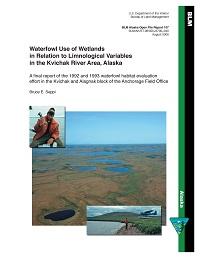Waterfowl Use of Wetlands in Relation to Limnological Variables in the Kvichak River Area, Alaska

The relationship between 20 habitat variables and use by duck broods and adult waterbirds of all species was investigated in 1992 and 1993 on 156 wetlands in the Kvichak River area, Alaska. The study examined whether wetland size and shape, water chemistry characteristics, primary productivity and aquatic invertebrate biomass affected the density of waterfowl on wetlands. Biases in the visibility and detectability of birds, especially duck broods, were recognized.
Results suggest brood use by all species of ducks was influenced by wetland cation concentrations, particularly sodium. Use by adult ducks and all species of waterbirds was related to total alkalinity and shoreline length. Limnological variables associated with swan use of wetlands were inconclusive, but general trends indicate productivity and salinity may be factors. On a density basis (birds/m shoreline), sodium, chlorophyll a, pH and total alkalinity most strongly influenced use by duck broods, adults and all species of waterbirds. These results suggest that large, relatively productive wetlands with low to moderate salinity were used most by waterfowl.
